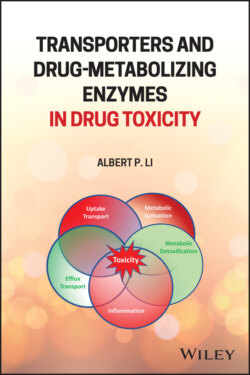Читать книгу Transporters and Drug-Metabolizing Enzymes in Drug Toxicity - Albert P. Li - Страница 13
1.1 Drug Toxicity as a Challenge in Drug Development
ОглавлениеDrug discovery and development is critical to human health. In recent decades, there have been numerous exciting breakthroughs in the development of novel approaches to cure previously difficult to manage diseases, alleviate pain and discomfort, as well as scientifically acceptable approaches to prevent or delay the onset of common but deadly disorders. The explosion in knowledge of the human genome has been instrumental in the development of novel therapeutic targets in the past decade, allowing the development of small molecules, biologics, and gene therapy to retard or completely abolish the progression of diseases via the modulation of key pathways. Human life span has been extended in most developed countries due to enhancements in health care approaches.
Unexpected human‐specific drug toxicity has been, and continues to be a major challenge in drug development (1–5). Pharmaceuticals by nature are biologically active chemicals designed to interact with biological pathways. Key uncertainties are the unintended biological effects which may lead to damage. Unintended drug toxicity is one of the major reasons for clinical trial failures as well as withdrawal or greatly limited use of drugs that have received regulatory approval. Unintended and unexpected drug toxicities are responsible for the high costs and time required for drug development. The most recent estimation of the cost for development of a new drug is over $1 billion USD, with the average time span from discovery to market of over 10 years (6, 7).
In drug development, approaches to develop drugs with acceptable safety margin to patients involve extensive preclinical evaluation in multiple species of laboratory animals. Only after the preclinical data support the safety of a drug candidate can it be submitted for approval by regulatory agencies for phase 1, 2, and 3 clinical trials. A drug is approved for marketing after the clinical trials support its safety and efficacy. The occurrence of unexpected toxicity for drug candidates with acceptable safety profile from preclinical safety studies is one of the major reasons for clinical trial failure, illustrating that nonhuman animals may not provide adequate information for the assessment of human drug toxicity. However, numerous drugs approved for marketing based on clinical trial demonstration of safety have been withdrawn from the market or have been restricted in use due to unacceptable adverse events leading to deaths. The occurrence of unacceptable drug toxicity after a drug is marketed to the human population illustrates that clinical trials do not have the statistical power to assure safety when millions of patients are exposed to a new drug. The paradigm for drug safety evaluation of preclinical safety in laboratory animals followed by regulatory human clinical trials therefore is not always adequate.
I strongly advocate the transition of the practice of toxicology from an empirical to a mechanistic discipline. A thorough mechanistic understanding of the onset of the toxic events is necessary for the identification of risk factors and the estimation of the probability of the patient population with the risk factors based on genetic polymorphism, coadministered prescribed and non‐prescribed medications, disease status, and life style factors such as diet, substance abuse, alcohol consumption, and the use of unregulated diet supplements and herbal medicines.
